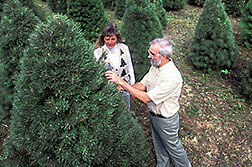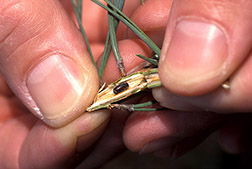The Grinch That Spoils Christmas Trees
|
|
Richard Dysart wasn't out collecting firewood when he cut and stacked pine logs last summer in the woods near Lodeve, France. An entomologist with the Agricultural Research Service, Dysart piled the wood to lure beneficial insects that may soon dine on destructive pine shoot beetles in the United States.
Pine shoot beetles, Tomicus piniperda, turned up in Ohio in 1992. They have spread to Illinois, Indiana, Maryland, Michigan, New York, Pennsylvania, and West Virginia.
In 1995, this six-legged spoiler threatened growers of pine Christmas trees in about 150 U.S. counties. But much more is at stake: 145 million acres of pine trees—30 percent of the nation's commercial timberland.
Some scientists believe the dark-brown, one-fifth-inch-long beetle stowed away on ships from Europe entering the Great Lakes via the St. Lawrence Seaway. The insects may have infested bark on rough-cut pine timber used as cargo crates or braces, says Dysart. He's based in Montpellier, France, at ARS' European Biological Control Laboratory.
To begin his search for natural enemies of Tomicus, Dysart first tapped the existing base of research knowledge. He relied strongly on studies by Montpellier colleague Franck Herard. Soon, Dysart focused on the biology, life cycle, and behavior of a predatory beetle, Thanasimus formicarius. One adult Thanasimus can eat about three pine shoot beetles daily for 2 or 3 months.
About three-eighths-inch long, Thanasimus resembles an ant—if the ant were wearing a cape colored with wavy bands of brick-red, black, and white. Scooting along pine trunks and branches, this predator strikes quickly. First it pins Tomicus, using mandibles and four front legs. Then, balancing on the back two legs and abdomen, it amputates the prey's legs, snips its body in two, and eats the insides.
Laurie Koelling of Okemos, Michigan, hasn't seen Thanasimus in action. In fact, she's seen only a few pine shoot beetles at the Christmas tree farm she and her husband operate. But even one Tomicus can be too many.
|
|
To slow this beetle's spread, USDA's Animal and Plant Health Inspection Service (APHIS) operates a quarantine in infested counties. If an inspector finds just one in a field at a tree farm or nursery, none of the field's pine trees, boughs, or logs can be shipped to Tomicus-free counties—unless, that is, these pine products meet requirements to ensure no live beetles accompany them.
"Some growers have lost contracts," says Koelling. She is executive director of the Michigan Christmas Tree Association. Christmas trees form a vigorous, $80 million branch of Michigan's economy, with 4 million sold in 1994.
Evidence of Tomicus' nibbling typically amounts to a few dead branch tips. These can be snipped off a Yule tree in seconds, and the pest doesn't threaten wood structures and furniture. So, why all the fuss?
Because, says Robert Haack of USDA's Forest Service, "in Europe and China, Tomicus beetles sometimes kill pine trees stressed by fire, drought, or defoliation. We haven't seen this in the United States. But the potential exists." In East Lansing, Michigan, Haack heads the Forest Insect Unit at the North Central Forest Experiment Station.
"Tomicus has attacked all of the dozen or so pine species we and our cooperators have tested," he says. "We're still evaluating spruce and other conifers, although fir, tamarack, and Douglas-fir don't seem to appeal to this beetle."
In early spring, adult pine shoot beetles emerge from winter hideaways—holes in bark near the base of a live pine. They search for pine branches, trunks, or stumps that died or were cut since autumn.
The female carves an egg gallery—a 3- to 5-inch tunnel, just beneath the bark. A male Tomicus appears, they mate, and she lays 50 to 100 eggs. She may set up three or four galleries before dying.
Eggs hatch and develop into hungry larvae. They dine on tree phloem—the inner bark, nonwoody vascular tissue—adding dozens of chambers to the egg gallery. Weeks later, young adult beetles depart the galleries. They spend summer maturing sexually—and tunneling in pine branch tips.
On tree farms, Haack says, growers may use IPM (integrated pest management) techniques to deprive Tomicus of breeding sites. Forest Service researchers and colleagues with APHIS and universities are investigating and refining IPM tactics. One tactic uses trap logs: They let Tomicus breed, but offspring are killed before they can leave the galleries.
|
|
Anti-breeding measures will be impractical, however, if the pest spreads to America's vast tracts of forests and pine plantations. Here, natural enemies could play a major role. They usually do control T. piniperda in its native range—from Portugal to Japan, and from the Arctic Circle to the Mediterranean. But in the United States, overwintering Tomicus adults emerge 4 to 8 weeks before native predators and parasites.
The European beetle, Thanasimus formicarius, has better timing. While Tomicus hunts for gallery sites, Thanasimus hunts for Tomicus. And, in bark crevices near Tomicus galleries, a female Thanasimus lays her eggs. She typically lays 160 to 310 over her lifetime. The larval offspring raid the galleries, eating Tomicus eggs, larvae, and pupae.
Dysart recruited Thanasimus almost every week last summer in a crucial early stage of a cooperative biocontrol project by ARS, APHIS, and the Forest Service. In the Lodeve Forest 45 miles from Montpellier, Dysart built waist-high stacks of fresh-cut pine logs. He topped the stacks with fresh pine branches and boughs.
Piney vapors attracted Tomicus and other bark beetles. They also served as chemical dinner bells for T. formicarius. "We shook the pine boughs over a sheet and picked up Thanasimus beetles that fell off," he says. "Apparently, they rest on the boughs while waiting to ambush arriving bark beetles."
Dysart sheltered some of the pine stacks with mesh-sided tents. From the netting, he plucked dozens of Thanasimus insects during his weekly rounds at Lodeve.
By summer's end, he had shipped more than 400 Thanasimus adults to ARS' Beneficial Insects Introduction Research Laboratory in Newark, Delaware. Quarantine officer Larry Ertle sent the immigrants' eggs and larval offspring to APHIS' National Biological Control Laboratory in Niles, Michigan.
There, APHIS entomologist David Prokrym and colleagues have been nursing the insects to adulthood, to set up supply lines to East Lansing.
"We're conducting lab studies to evaluate this European predator, and we may test-release it outdoors in 1997," says Haack, the Forest Service researcher.
"First we want to gauge what effect the newcomer might have on native insects, especially on our native natural enemies of pine bark beetles." — By Jim De Quattro, ARS.
Richard Dysart is at the USDA-ARS European Biological Control Laboratory, Montpellier, France.
Robert Haack is at the USDA Forest Service, North Central Research Station, 1407 S. Harrison Road, Room 220, East Lansing, MI 48823; phone (517) 355-7740; ext. 108, fax (517) 355-5121.
"The Grinch That Spoils Christmas Trees" was published in the December 1995 issue of Agricultural Research magazine.









